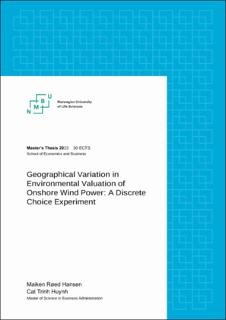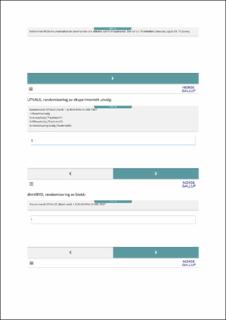| dc.contributor.advisor | Anders Dugstad | |
| dc.contributor.author | Hansen, Maiken Røed | |
| dc.contributor.author | Huynh, Cat Trinh | |
| dc.date.accessioned | 2023-07-06T16:28:28Z | |
| dc.date.available | 2023-07-06T16:28:28Z | |
| dc.date.issued | 2023 | |
| dc.identifier | no.nmbu:wiseflow:6839595:54592451 | |
| dc.identifier.uri | https://hdl.handle.net/11250/3076783 | |
| dc.description.abstract | The main purpose of this study is to investigate Norwegian households' preferences and willingness to pay (WTP) for wind power development (WPD), focusing on the different regions in Norway and exposure to wind turbines. The analysis of the environmental and social impact of wind power development will contribute to a better understanding of the balance between meeting the demand for renewable energy and preserving nonmarket environmental goods.
We have used secondary data that was carried out for the research project LandValUse (project number 319917) to investigate Norwegian households' preferences for wind power. The survey was designed as a discrete choice experience with 3 412 respondents. The multinomial logit model is employed as the chosen econometric method to analyse the data and estimate the respondent's preferences.
Our results only find some significant differences in WTP between the regions in Norway to avoid additional wind turbines. In addition, there are no significant differences for an increase in renewable energy. Western Norway significantly differs from Eastern Norway in WTP, whereas Western Norway is willing to pay more to avoid increasing turbines at all levels. We also found a significant difference between Western- and Southern Norway for an additional 1 400 turbines, with Western Norway again having higher WTP to avoid WPD. However, our results show that all regions are willing to pay for an increased grid fee to avoid additional onshore WPD. Similarly, all regions are willing to pay more to increase renewable energy.
Our research results indicate no substantial differences between people who are exposed and non-exposed to WPD within a region that is already exposed to WPD. Also, our research found no significant difference in comparing the two regions already exposed to WPD. In addition, we compared our results to previous research that investigated WTP between Oslo and Rogaland. We found similarities as Rogaland respondents were willing to pay more to avoid WPD than those from Oslo. We also discovered a difference as our study found no significant difference between the two counties regarding an increase in renewable energy. Finally, we compared our results to Dugstad et al. (2020) to see if there were any changes over time. Our data is only collected three years apart, so we found no significant difference over time. | |
| dc.description.abstract | The main purpose of this study is to investigate Norwegian households' preferences and willingness to pay (WTP) for wind power development (WPD), focusing on the different regions in Norway and exposure to wind turbines. The analysis of the environmental and social impact of wind power development will contribute to a better understanding of the balance between meeting the demand for renewable energy and preserving nonmarket environmental goods.
We have used secondary data that was carried out for the research project LandValUse (project number 319917) to investigate Norwegian households' preferences for wind power. The survey was designed as a discrete choice experience with 3 412 respondents. The multinomial logit model is employed as the chosen econometric method to analyse the data and estimate the respondent's preferences.
Our results only find some significant differences in WTP between the regions in Norway to avoid additional wind turbines. In addition, there are no significant differences for an increase in renewable energy. Western Norway significantly differs from Eastern Norway in WTP, whereas Western Norway is willing to pay more to avoid increasing turbines at all levels. We also found a significant difference between Western- and Southern Norway for an additional 1 400 turbines, with Western Norway again having higher WTP to avoid WPD. However, our results show that all regions are willing to pay for an increased grid fee to avoid additional onshore WPD. Similarly, all regions are willing to pay more to increase renewable energy.
Our research results indicate no substantial differences between people who are exposed and non-exposed to WPD within a region that is already exposed to WPD. Also, our research found no significant difference in comparing the two regions already exposed to WPD. In addition, we compared our results to previous research that investigated WTP between Oslo and Rogaland. We found similarities as Rogaland respondents were willing to pay more to avoid WPD than those from Oslo. We also discovered a difference as our study found no significant difference between the two counties regarding an increase in renewable energy. Finally, we compared our results to Dugstad et al. (2020) to see if there were any changes over time. Our data is only collected three years apart, so we found no significant difference over time. | |
| dc.language | eng | |
| dc.publisher | Norwegian University of Life Sciences | |
| dc.title | Geographical Variation in Environmental Valuation of Onshore Wind Power: A Discrete Choice Experiment | |
| dc.type | Master thesis | |

